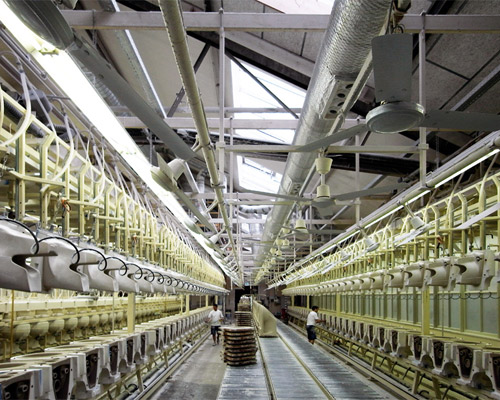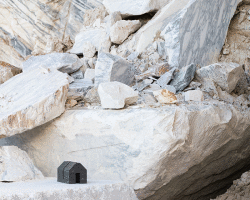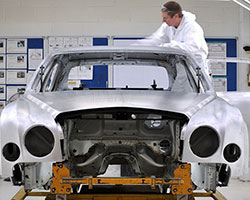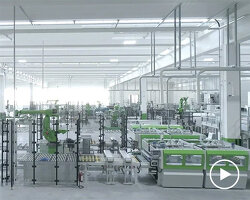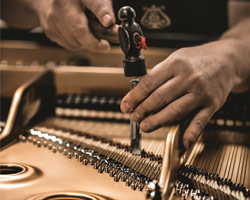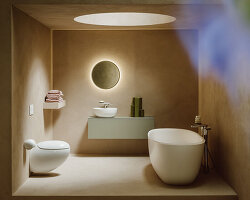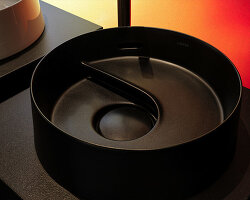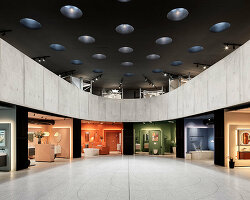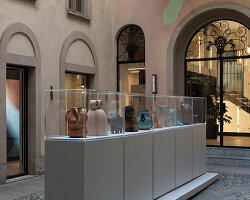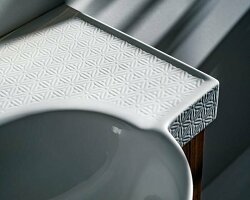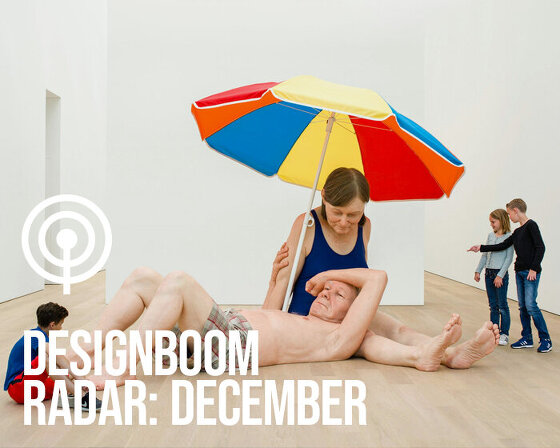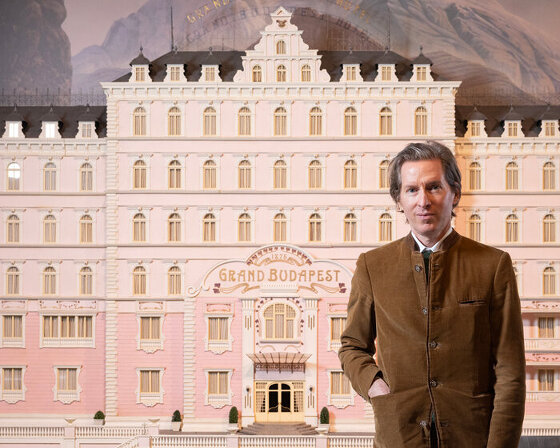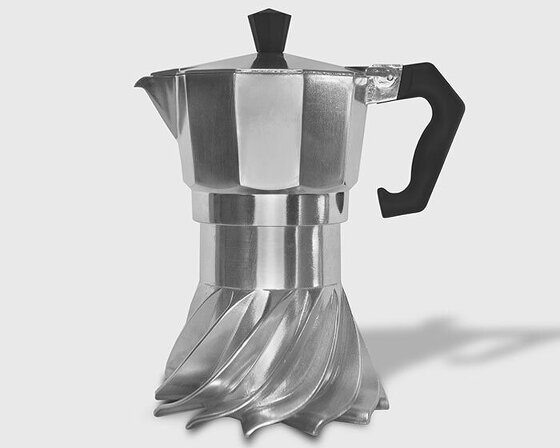the LAUFEN ceramic factory and home of bathroom culture, located in laufen, switzerland since 1892 image © designboom
this june, designboom requested a manufacturing tour of LAUFEN ceramics factory. we had the opportunity to document the many steps and design considerations that go into the production of bathroom fittings, offering a better understanding of the different design criteria and production methods required for these everyday household pieces, as well as the way in which such an ancient material as ceramic is being utilized in high-tech and industrial applications in the present day. we’ll bring you a behind-the-scenes look at this field of design in a series of articles, beginning now with a look at the ceramic production floor.
there are few places in the world that offer the synergism of traditional craftsmanship and state-of-the-art technology in the way that the LAUFEN factory does. in a place where water, earth, and fire are finessed by human hands into the finest home products, the hum of fans and spinning of machinery offer aural contrast to the earthy scent of clays, as craftsmen zoom around the soaring-ceilinged rooms on small trolleys, or work seamlessly with automated robots as they mount, transpose, and glaze fresh ceramicware.
 raw materials are stored just outside the LAUFEN factory floor, to be mixed into slip that circulates in special pipes below the building image © designboom
raw materials are stored just outside the LAUFEN factory floor, to be mixed into slip that circulates in special pipes below the building image © designboom
founded in 1892 in the swiss town of laufen just outside basel, LAUFEN has grown into one of the most respected bathroom ceramics makers in the entire industry. well-known for its designer bathrooms, developed with famed collaborators like wiel arets and stefano giovannoni, LAUFEN places an equal emphasis on technical superiority of its products, and has developed revolutionary production techniques towards the creation of both ceramics and the internal technical systems that render sinks, toilets, and bidets their high level, long-term functionality.
the LAUFEN design philosophy has its roots in two schools: emotional, artistic italian design from the south and meticulous swiss precision from the north. the swiss center still serves as the industrial base and heart of the company, even as LAUFEN has developed factories in the czech republic cities of znojmo and bechyně and austrian centers of wilhemsburg and gmunden, all sites that already boasted a rich tradition in ceramic-making. as designboom saw firsthand, every piece that comes out of any of these five factories has endured rigorous testing at every step of its life, its form finessed and meticulously inspected by hand. it is this continued emphasis on the handmade, artisan touch that distinguishes LAUFEN products in their exceptional quality.
 ceramic slip is composed of a special recipe of raw materials, including clay, quartz, and feldspar images © designboom
ceramic slip is composed of a special recipe of raw materials, including clay, quartz, and feldspar images © designboom
in this multipart series, designboom takes an inside look at LAUFEN’s home factory. in addition to its production facilities for ceramic, LAUFEN develops in-house all of the plaster molds and much of the mechanical equipment that drive its pipeline. extensive materials research offer a technical edge to the company’s design facilities, while extensive testing and meticulous quality control ensure that each piece leaves the factory in perfect condition. but LAUFEN’s perspective is also wider, establishing education centers and training courses to ensure the proper installation of their products, and developing a new production building that incorporates sustainable energy recollection techniques.
in this first article, we’ll visit the floor of the LAUFEN factory, as we trace the progress of these special ceramics from a powder of clay and crushed quartz to a formed, finished, and glazed piece, ready for firing in the kiln.
 the slip is fed to these raised cisterns, where churning motors beat the material to the right consistency image © designboom
the slip is fed to these raised cisterns, where churning motors beat the material to the right consistency image © designboom
alongside the outer edge of the factory, large stores of clay, quartz, and feldspar are brought together in careful proportions to create the slip that will become the ceramic. the powders are dissolved together in large quantities of water in a holding tank that runs underneath parts of the factory floor, before being pumped into cisterns where pulsing motors mix the material and ensure that the slip is of the correct consistency.
already at each of these stages, samples of the slip are taken and sent for laboratory testing in particle size, viscosity, and composition. the high level of technical and aesthetic excellence that LAUFEN places on its products depend on the uniformity of their ceramic, a material in which even small changes in consistency offer large variation in the way in which it responds to water, firing, and moldings in later processes. the factory itself, cooled primarily with fans, must also adhere to careful climate controls for temperature and humidity, so as to not negatively affect the development of the ceramic.
 view from the raised platform where the slip is being churned to the proper consistency image © designboom
view from the raised platform where the slip is being churned to the proper consistency image © designboom
entering into the first casting hall, one immediately encounters the factory’s glass-enclosed laboratory for the testing of raw materials, namely glazes and the slip. to its left, two floors of storage racks support large blue containers already filled with prepared glaze, also made in-house and likewise awaiting testing.
 a beating motor ensures that all slip is of uniform consistency image © designboom
a beating motor ensures that all slip is of uniform consistency image © designboom
 scenes from the factory floor, preparing the slip images © designboom
scenes from the factory floor, preparing the slip images © designboom
the raw materials used to create the product video © designboom
with such a wide range of products, LAUFEN’s production pipeline is split into two primary segments in the casting stage: traditional plaster casting and LAUFEN’s own pressure casting technology, which revolutionized the industry in 1985 by reducing the production time of a finished cast from one hour to about ten minutes. within the framework of plaster casting, LAUFEN further subdivides its pieces into the automated assembly line, wherein craftsmen work side-by-side with machines and sliding storage systems to develop each product, and the small completely handmade pipeline, which represents about 1-2% of all LAUFEN productions and is reserved for highly limited edition pieces.
whether formed with plaster molds or through pressure casting, LAUFEN’s signature quality relies on specialized craftsmen to inspect and refine each piece by hand. working with deft speed but careful precision, these skilled workers sweep down long rows of fresh molds, with sponges and specialty sanding tools in hand as they remove any raw pieces and smooth away any rough surfaces.
 a wheeled rail system in the automated production line facilitates the closing and filling of molds, and then the opening and removal of each piece image © designboom
a wheeled rail system in the automated production line facilitates the closing and filling of molds, and then the opening and removal of each piece image © designboom
in the first of the LAUFEN’s plaster casting halls, washbasins, pedestals, and other ceramicwork are being formed. long rows of molds, each set on a wheeled rail system to easily open and close the two halves of the full form, are filled with slip and left to set.
plaster is selected as the material for the mold for its water absorbency. once the molds are filled with raw ceramic material, the plaster begins to absorb the water out of the slip, leaving behind over the course of an hour a ceramic form about eight to nine millimeters thick. at this point, LAUFEN craftsmen arrive to drain out the remaining liquid.
 plaster molds on a sliding, wheeled rail system (top left and right) facilitates the removal of ceramic casts (bottom right) images © designboom
plaster molds on a sliding, wheeled rail system (top left and right) facilitates the removal of ceramic casts (bottom right) images © designboom
 the handmade production workstation at LAUFEN is used to develop limited edition, specialty pieces image © designboom
the handmade production workstation at LAUFEN is used to develop limited edition, specialty pieces image © designboom
continuing further into the casting hall, one arrives at the last fully manual workstation of LAUFEN. ‘until twenty years ago, everything was like that‘, explains simon imhof, plant manager of the laufen-based factory. now, the inclusion of automated machinery reduces the physical strain on workers for 97% of LAUFEN’s production line. this last remaining completely handpowered workspace — where men must lift the filled molds (which empty already weigh 110 to 132 pounds, or 50-60kg), and stabilize and drain them before removing the cast work– is used for the creation of limited edition pieces.
 in the last machine-less part of the factory, craftsmen must lift, fill, and drain plaster molds entirely by hand image © designboom
in the last machine-less part of the factory, craftsmen must lift, fill, and drain plaster molds entirely by hand image © designboom
 storage aisle for the plaster molds used in part of LAUFEN’s production line image © designboom
storage aisle for the plaster molds used in part of LAUFEN’s production line image © designboom
 in the LAUFEN production hall for specialty products, craftsmen work together with high-tech machinery to produce complex units like toilets and urinals image © designboom
in the LAUFEN production hall for specialty products, craftsmen work together with high-tech machinery to produce complex units like toilets and urinals image © designboom
just a short walk away, the LAUFEN production hall for specialty products offers a development line for toilets and urinals, two of the most complicated products to create. the pieces are so difficult because of all the internal components required, which need to each be taken out from the molds in a certain order in order to be properly replaced afterwards.
in this hall, companion pieces– a toilet basin and its rim, for example– are matched up along parallel workbenches, where LAUFEN craftsmen assemble the two still-wet, raw clay forms together by hand, with a carefully applied line of slip serving as the glue. all within about 30 seconds, the same artisan carefully seals the seam between the components with finger pressure.
 skilled craftsmen hand-assemble each LAUFEN product; here, a man affixes toilet rims to the bowls, using additional slip as the glue images © designboom
skilled craftsmen hand-assemble each LAUFEN product; here, a man affixes toilet rims to the bowls, using additional slip as the glue images © designboom
 image © designboom
image © designboom
 a craftsman has left gloves on urinals to prevent dry cracks, as he closes the hole left by the filling of the plaster casts with slip image © designboom
a craftsman has left gloves on urinals to prevent dry cracks, as he closes the hole left by the filling of the plaster casts with slip image © designboom
here, machine and man are working together in incredibly efficient concert. as one craftsmen loads in the drying plaster cast, a ‘de-molding machine’ upturns the mold, and the internal ceramic is swiftly removed and stored by the worker. despite the seamless process, the complexity of the products means that a single man can produced only 20 to 30 pieces per day.
next door, a production bench for higher volume products accomplishes the same end goals, at the rate of about 70 pieces per day per craftsman. in both production lines, workers come to each piece individually, examining the quality of the ceramic and cleaning off any rough edges with a sponge.
 production line of cast pieces image © designboom
production line of cast pieces image © designboom
 emptied plaster molds image © designboom
emptied plaster molds image © designboom
the molds for LAUFEN products are also made at the swiss factory. each carries a lifespan of about 50 days, used twice a day, for a total of 100 uses before the unit is replaced, to prevent the abrasive particles in the slip from creating gradual imperfections in the form of the plaster. overnight, all molds are heated to 95°F (35°C) to completely dry out.
 every LAUFEN product is sponged and polished by hand to clean away extra raw material and smooth out rough edges images © designboom
every LAUFEN product is sponged and polished by hand to clean away extra raw material and smooth out rough edges images © designboom
 the 4-mold pressure casting machine, a technology developed and built at LAUFEN for faster ceramic production image © designboom
the 4-mold pressure casting machine, a technology developed and built at LAUFEN for faster ceramic production image © designboom
creating the mold of the product video © designboom
as streamlined as the plaster molding process is, with its equal incorporation of skilled craftsmen and advanced machines, it is not the only casting technique that LAUFEN uses. it was in 1985 that LAUFEN revolutionized the production technique for sanitary ceramics when it developed the system of high pressure casting. some of the first pressure casting machines are still at its switzerland home factory, although the technology is now also used under license by other companies in the industry. all of the company’s new pressure casting machines continue to be built in-house at LAUFEN’s swiss plant.
 a LAUFEN technician removes a freshly formed cast from the pressure casting machine, whose two mold halves are visible to the worker’s left and right in the photograph image © designboom
a LAUFEN technician removes a freshly formed cast from the pressure casting machine, whose two mold halves are visible to the worker’s left and right in the photograph image © designboom
pressure casting involves the use of high pressure (14 – 16 bars) to press liquid slip in its molds, causing the rapid drainage of water from the material and creating a formed piece of the proper thickness in about ten to twelve minutes instead of the hour that plaster casting requires. molds for this technique are composed of porous resin rather than plaster, since there is no need for the mold to absorb water from the slip.
each machine in the pressure casting production line is specific to one mold. in certain parts of the factory, up to four molds are mounted next to one another in the machine, further speeding the rate of production. skilled workers still open the mold by hand when complete, before the piece continues onto further stages in its development process.
 pipeline of formed pieces removed from the pressure casting machine image © designboom
pipeline of formed pieces removed from the pressure casting machine image © designboom
 holding racks alongside the 4-mold pressure caster image © designboom
holding racks alongside the 4-mold pressure caster image © designboom
 finished casts await drying and glazing image © designboom
finished casts await drying and glazing image © designboom
before arriving at the glazing rooms of the LAUFEN factory, all pieces must be thoroughly dried. any excess water in the material poses the risk that it will explode in the kiln as the liquid heats into water vapor, destroying not only itself but also large amounts of other product being fired. as a result, the LAUFEN drying machine leaves less than 1% of water in each piece. other than for extremely large pieces like washbasins, all products enter into a automated production line. as the pieces come out of the dryer, a transfer car takes each piece, and places it along one of three glazing production lines, using the object’s barcode to determine which one.
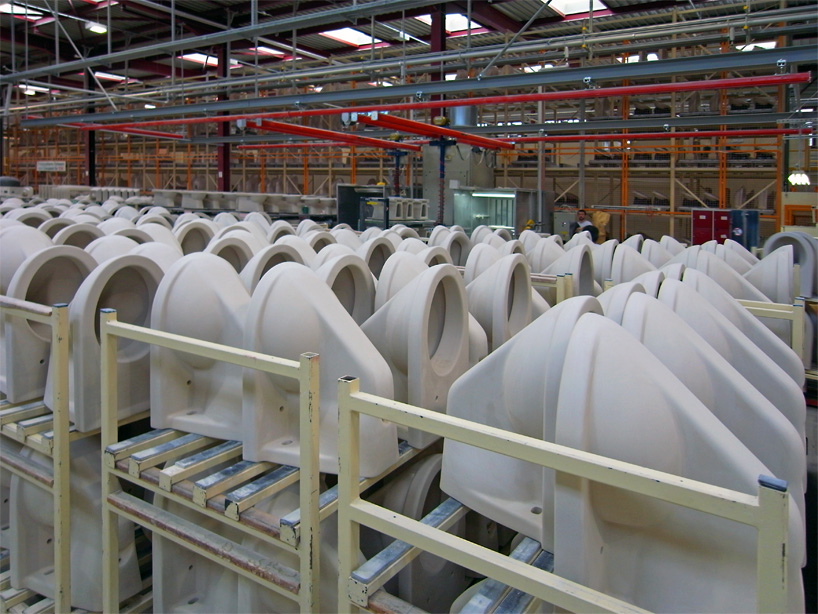 pieces await drying image © designboom
pieces await drying image © designboom
walking through the LAUFEN factory through this stage, it is easy to forget the delicacy and softness that characterizes ceramic before firing. craftsmen deftly handle large pieces, moving them flawlessly from one space to another when the material is still at a stage when the slightest mistouch would cause an imprint or deformation that renders the entire object unusable by LAUFEN’s strict quality standards.
indeed, a small percentage of formed pieces do not finish the production process, but until the glazing stage, any defective casts can be recycled back into the slip supply.
every piece produced by LAUFEN receives its own barcode, which identifies the product throughout its journey through the factory. every moment of its life is tracked, including the date and time that it passed each stage of production and testing, and the name of the technician who worked to complete each step. the quality control mechanism is in place exclusively at LAUFEN’s original swiss factory, although its other locations in austria and the czech republic utilize a stamp system for a similar level of quality assurance.
 image © designboom
image © designboom
keep posted to designboom for the next installation in the series, which brings these carefully crafted ceramic pieces under the precise eyes of robots and craftsmen alike for glazing and into 2300°F (1250°C) heat for firing in the LAUFEN kilns!
